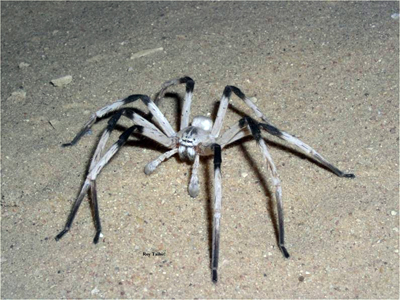 Cerbalus aravensis (Photo by Roy Talbi)
Cerbalus aravensis (Photo by Roy Talbi)
________________________________________________________________
HAIFA (Press Release)–A new and previously unknown species of spider has been discovered in the dune of the Sands of Samar in the southern Arava region by a team of scientists from the Department of Biology in the University of Haifa-Oranim. Unfortunately, however, its habitat is endangered. “The discovery of this new spider illustrates our obligation to preserve the dune,” says Dr. Shanas, who headed the team of scientists.
The Sands of Samar are the last remaining sand dune in Israeli territory in the southern Arava region. In the past, the sands stretched across some 7 square kilometers, but due to the rezoning of areas for agriculture and sand quarries, the sands have been reduced to fewer than 3 square kilometers.
During a course of studies that Dr. Shanas’s research team has carried out in the region, they discovered this new spider, a member of the Cerbalus genus. Since it has been found in the Arava, it has been given the name Cerbalus aravensis. The researchers say that this spider’s leg-span can reach up to 14 cm., which makes it the largest spider of its type in the Middle East. Even though details are still lacking to enable a full analysis of its biology and of its population in the sands, the scientists know that this is a nocturnal spider, mostly active in the hottest months of the year, and that it constructs an underground den which is closed with a “lifting door” made of sand particles that are glued together to camouflage the den.
The scientists’ excitement is indeed mixed with apprehension. According to Dr. Shanas, the Israel Land Administration intends to renew mining projects in the Sands of Samar in the near future, which will endanger the existence of the newly discovered spider. He adds that it is possible that there are additional unknown animal species living in the sands, and therefore efforts should be made to preserve this unique region in the Arava. “The new discovery shows how much we still have to investigate, and that there are likely to be many more species that are unknown to us. If we do not preserve the few habitats that remain for these species, they will become extinct before we can even discover them,” Dr. Shanas concludes.
*
Preceding provided by the University of Haifa